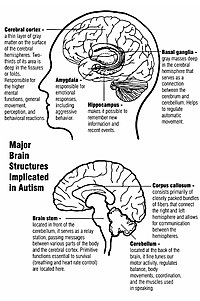
Photo from wikipedia
Abstract Aims Autism spectrum disorder (ASD) is a neurodevelopmental condition, with symptoms appearing in the early developmental period. Little is known about its current burden at the global, regional and… Click to show full abstract
Abstract Aims Autism spectrum disorder (ASD) is a neurodevelopmental condition, with symptoms appearing in the early developmental period. Little is known about its current burden at the global, regional and national levels. This systematic analysis aims to summarise the latest magnitudes and temporal trends of ASD burden, which is essential to facilitate more detailed development of prevention and intervention strategies. Methods The data on ASD incidence, prevalence, disability-adjusted life years (DALYs) in 204 countries and territories between 1990 and 2019 came from the Global Burden of Disease Study 2019. The average annual percentage change was calculated to quantify the secular trends in age-standardised rates (ASRs) of ASD burden by region, sex and age. Results In 2019, there were an estimated 60.38 × 104 [95% uncertainty interval (UI) 50.17–72.01] incident cases of ASD, 283.25 × 105 (95% UI 235.01–338.11) prevalent cases and 43.07 × 105 (95% UI 28.22–62.32) DALYs globally. The ASR of incidence slightly increased by around 0.06% annually over the past three decades, while the ASRs of prevalence and DALYs both remained stable over the past three decades. In 2019, the highest burden of ASD was observed in high-income regions, especially in high-income North America, high-income Asia Pacific and Western Europe, where a significant growth in ASRs was also observed. The ASR of ASD burden in males was around three times that of females, but the gender difference was shrunk with the pronounced increase among females. Of note, among the population aged over 65 years, the burden of ASD presented increasing trends globally. Conclusions The global burden of ASD continues to increase and remains a major mental health concern. These substantial heterogeneities in ASD burden worldwide highlight the need for making suitable mental-related policies and providing special social and health services.
Journal Title: Epidemiology and Psychiatric Sciences
Year Published: 2022
Link to full text (if available)
Share on Social Media: Sign Up to like & get
recommendations!